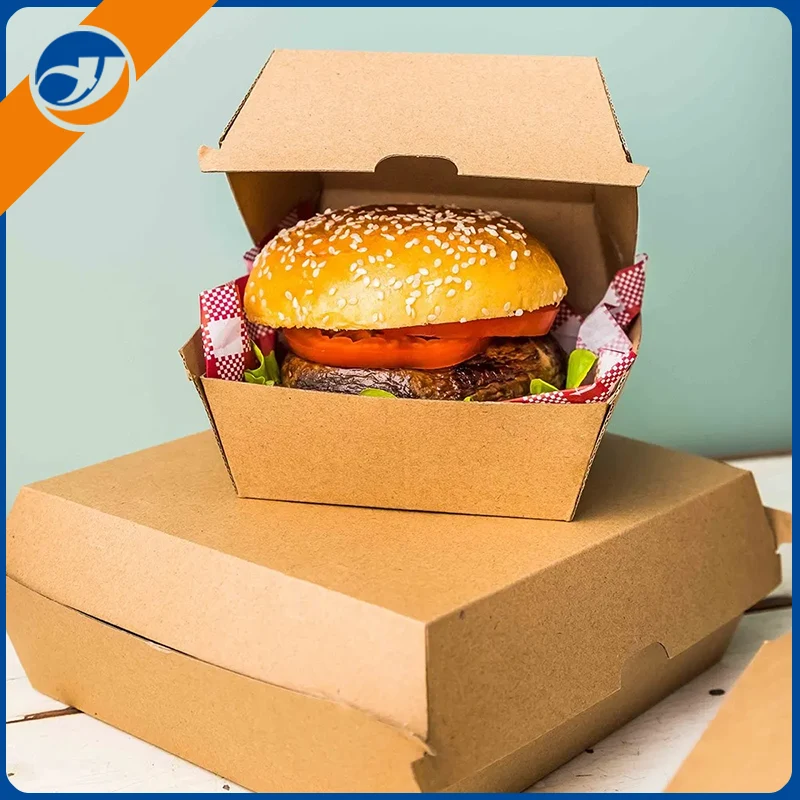What Materials Are Commonly Used to Make Hamburger Boxes?
2025-02-06
When you grab a hamburger from your favorite fast food joint, you likely notice that it's wrapped up in a box that serves more than just a practical purpose of holding the burger. The hamburger box plays a vital role in the foodservice industry, providing both functionality and branding opportunities for restaurants. But have you ever wondered what materials go into making these ubiquitous boxes?
1. Cardboard: The Classic Choice
Cardboard is the most commonly used material for hamburger boxes, and for good reason. It offers a range of benefits, including cost-effectiveness, durability, and flexibility in design. Most fast food chains use corrugated cardboard or paperboard to create their boxes.
Why Cardboard?
- Lightweight & Strong: Cardboard is sturdy enough to protect the burger during transport but lightweight enough to keep shipping costs down.
- Eco-Friendly Options: Many restaurants now opt for recycled or recyclable cardboard, helping to reduce the environmental impact of packaging waste.
- Customizable: Cardboard is easy to print on, making it ideal for branding. Fast food chains can print their logos, promotions, or messages directly on the box.
Drawbacks of Cardboard:
- Moisture Absorption: Cardboard can absorb moisture from greasy food, which may cause the box to weaken and affect its ability to hold the food securely.
- Limited Insulation: While cardboard can offer some level of insulation, it doesn’t do much to maintain the temperature of the food for extended periods.
2. Kraft Paper: The Eco-Friendly Option
Kraft paper is a type of paper made from wood pulp that has been chemically treated. Known for its natural brown color and durability, Kraft paper is another material used to make hamburger boxes.
Why Kraft Paper?
- Biodegradable & Recyclable: Kraft paper is often praised for being an environmentally friendly material. It can be easily recycled and is biodegradable, making it a popular choice for eco-conscious brands.
- Sturdy Construction: Though it’s lighter than cardboard, Kraft paper is tough enough to hold a burger and fries without compromising the box’s integrity.
- Minimalistic Look: The natural brown appearance of Kraft paper is appealing to customers who prefer a more rustic or eco-friendly aesthetic.
Drawbacks of Kraft Paper:
- Limited Moisture Protection: Like cardboard, Kraft paper can struggle with moisture, which can weaken the box and affect the food’s freshness.
- Not as Customizable: While Kraft paper can be printed on, the printing quality might not be as vibrant or detailed as cardboard boxes.
3. Microwavable Paperboard: Convenience Meets Function
For fast food chains offering drive-through services or food delivery, microwavable paperboard has become a popular choice. This material is treated to withstand heat and is designed to maintain its integrity even when exposed to high temperatures.
Why Microwavable Paperboard?
- Heat Resistance: This material can withstand the heat from a freshly made burger without compromising the box’s structure.
- Convenience: It allows customers to reheat their food in the microwave without needing to transfer it to a different container.
- Grease-Resistant Coating: Microwavable paperboard often comes with a coating that resists oil and grease, helping the box stay intact even with a juicy burger.
Drawbacks of Microwavable Paperboard:
- More Expensive: Microwavable paperboard tends to be a bit pricier than regular cardboard or Kraft paper options.
- Not Always Eco-Friendly: While some paperboard is recyclable, not all types can be recycled due to the coatings used to make it microwavable or grease-resistant.
4. Plastic: For Enhanced Durability
Though less common, plastic hamburger boxes are sometimes used in certain fast food chains, especially in situations where extra durability is required. These boxes are typically made from polypropylene or PET plastic.
Why Plastic?
- Durability: Plastic boxes can withstand heavier loads and are less prone to breaking or collapsing under the weight of a large burger or additional items like fries.
- Moisture Resistance: Unlike paper-based boxes, plastic boxes don’t absorb moisture, keeping the box intact even with greasy or juicy foods.
- Reusable Option: Some plastic hamburger boxes are designed to be reused, offering a more sustainable option over time.
Drawbacks of Plastic:
- Environmental Impact: Plastic is not biodegradable, and its production and disposal contribute to environmental pollution.
- Limited Branding Flexibility: While plastic boxes can be printed on, they may not offer the same design flexibility as cardboard or paper alternatives.
5. Compostable Materials: A Growing Trend
With increasing environmental concerns, many fast food chains have begun exploring compostable materials for their hamburger boxes. These boxes are often made from plant-based fibers or bioplastics, offering an eco-friendly alternative to traditional packaging.
Why Compostable Materials?
- Eco-Friendly: Compostable boxes break down naturally, reducing waste in landfills. They are made from renewable resources like sugarcane fiber, bamboo, or cornstarch.
- Grease and Water Resistant: Many compostable materials are naturally resistant to moisture and grease, making them a great choice for food packaging.
- Sustainability Commitment: Using compostable packaging aligns with brands’ sustainability goals and appeals to environmentally conscious consumers.
Drawbacks of Compostable Materials:
- Cost: Compostable materials are typically more expensive than conventional packaging options, making them less accessible for all businesses.
- Availability: The infrastructure for composting is not universally available, so customers may not be able to compost their boxes easily depending on their location.
When it comes to choosing materials for hamburger boxes, there’s a delicate balance between cost, functionality, sustainability, and customer experience. While cardboard and Kraft paper remain the most common choices due to their affordability and versatility, eco-friendly options like compostable materials are gaining ground as sustainability becomes a priority for both businesses and consumers. Whatever the material, the goal remains the same: to deliver a safe, practical, and enjoyable experience for customers, while also minimizing the environmental impact.
As consumer preferences shift and technology advances, the future of hamburger box materials will likely continue to evolve, focusing on better performance, lower environmental impact, and more innovative designs.



